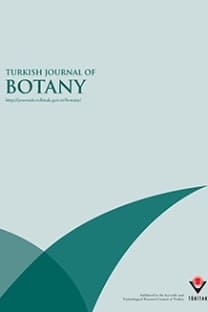Bacterial auxin signaling: comparative study of growth induction in Arabidopsis thaliana and Triticum aestivum
Arabidopsis, bacterial auxin, bacteria, interaction, plant growth promotion
Bacterial auxin signaling: comparative study of growth induction in Arabidopsis thaliana and Triticum aestivum
Arabidopsis, bacterial auxin, bacteria, interaction, plant growth promotion,
___
- Akhtar S, Ali B (2011). Evaluation of rhizobacteria as non-rhizobial inoculants for mung beans. Aust J Crop Sci 5: 1723–1729.
- Ali B, Sabri AN, Ljung K, Hasnain S (2009a). Auxin production by plant associated bacteria: impact on endogenous IAA content and growth of Triticum aestivum L. Lett Appl Microbiol 48: 542–547.
- Ali B, Sabri AN, Ljung K, Hasnain S (2009b). Quantification of indole-3-acetic acid from plant associated Bacillus spp. and their phytostimulatory effect on Vigna radiata (L.). World J Microbiol Biotechnol 25: 519–526.
- Baca BE, Elmerich C (2007). Microbial production of plant hormones. In: Elmerich C, Newton WE, editors. Associative and Endophytic Nitrogen-Fixing Bacteria and Cyanobacterial Associations. Dordrecht, Germany: Springer, pp. 113–144.
- Bektaş E, Cüce M, Sökmen A (2013). In vitro germination, protocorm formation, and plantlet development of Orchis coriophora (Orchidaceae), a naturally growing orchid species in Turkey. Turk J Bot 37: 336–342.
- Bloemberg GV, Lugtenberg BJJ (2001). Molecular basis of plant growth promotion and biocontrol by rhizobacteria. Curr Opin Plant Biol 4: 343–350.
- Domenech J, Ramos SB, Probanza A, Lucas GJA, Gutierrez MFJ (2007). Elicitation of systemic resistance and growth promotion of Arabidopsis thaliana by PGPRs from Nicotiana glauca: a study of the putative induction pathway. Plant Soil 290: 43–50.
- Jonsson P, Gullberg J, Nordström A, Kusano M, Kowalczyk M, Sjöström M, Moritz T (2004). A strategy for identifying differences in large series of metabolomics samples analyzed by GC/MS. Anal Chem 76: 1738–1745.
- Khalid A, Arshad M, Zahir ZA (2004). Screening plant growth- promoting rhizobacteria for improving growth and yield of wheat. J Appl Microbiol 96: 473–480.
- Mantelin S, Touraine B (2004). Plant growth-promoting bacteria and nitrate availability: impact on root development and nitrate uptake. J Exp Bot 55: 27–34.
- Murashige T, Skoog F (1962). A revised medium for rapid growth and bioassay with tobacco tissue culture. Physiol Plantarum 15: 473–497.
- Noreen S, Ali B, Hasnain S (2012). Growth promotion of Vigna mungo (L.) by Pseudomonas spp. exhibiting auxin production and ACC-deaminase activity. Ann Microbiol 62: 411–417.
- Pang PP, Meyerowitz EM (1987). Arabidopsis thaliana: a model system for plant molecular biology. Nat Biotechnol 5: 1177– 1181.
- Persello-Cartieaux F, David P, Sarrobert C, Thibaud M, Achouak W, Robaglia C, Nussaume L (2001). Utilization of mutants to analyze the interaction between Arabidopsis thaliana and its naturally root-associated Pseudomonas. Planta 212: 190–198.
- Ryu C, Farag MA, Hu C, Reddy MS, Wei H, Pare PW, Kloepper JW (2003). Bacterial volatiles promote growth in Arabidopsis. Natl Acad Sci 100: 4927–4932.
- Ryu C, Hu C, Locy RD, Kloepper JW (2005). Study of mechanisms for plant growth promotion elicited by rhizobacteria in Arabidopsis thaliana. Plant Soil 268: 285–292.
- Ryu C, Murphy JF, Reddy MS, Kloepper JW (2007). A two strain mixture of rhizobacteria elicits induction of systemic resistance against Pseudomonas syringae and Cucumber mosaic virus coupled to promotion of plant growth on Arabidopsis thaliana. J Microbiol Biotechnol 17: 280–286.
- Vespermann A, Kai M, Piechulla B (2007). Rhizobacterial volatiles affect the growth of fungi and Arabidopsis thaliana. Appl Environ Microbiol 73: 5639–5641.
- Vessey JK (2003). Plant growth promoting rhizobacteria as biofertilizers. Plant Soil 255: 571–586.
- Woodward AW, Bartel B (2005). Auxin: regulation, action and interaction. Ann Bot 95: 707–735.
- Yıldız M, Sağlık Ç, Telci C, Erkılıç EG (2011). The effect of in vitro competition on shoot regeneration from hypocotyl explants of Linum usitatissimum. Turk J Bot 35: 211–218.
- Zafar M, Abbasi MK, Khan MA, Khaliq A, Sultan T, Aslam M (2012). Effect of plant growth promoting rhizobacteria on growth, nodulation and nutrient accumulation of lentil under controlled conditions. Pedosphere 22: 848–859.
- ISSN: 1300-008X
- Yayın Aralığı: 6
- Yayıncı: TÜBİTAK
A new species of Bondarzewia from India
Kanad DAS, Arvind PARIHAR, Manoj Emanuel HEMBROM
Tanacetum erzincanense (Asteraceae), a new species from Erzincan, Turkey
Mustafa KORKMAZ, Ali KANDEMİR, Veli İLHAN, Nalan Yildirim DOĞAN
A computerized image database for freshwater algae recorded in Turkey
Bülent ŞEN, Feray SÖNMEZ, Ahmet Kadri ÇETİN, Mehmet Tahir ALP, Tülay Baykal ÖZER
Notes on Astragalus sect. Hymenostegis (Fabaceae) from Turkey
Seher Karaman ERKUL, Ali BAGHERI, Ali Asghar MAASSOUMI, Mohammad Reza RAHIMINEJAD
Mahsa KAVOUSI, Mostafa ASSADI, Taher NEJADSATTARI
Plant functional types in Mediterranean enclaves in Western Black Sea Region of Turkey
Emire ELMAS, Hamdi Güray KUTBAY
Lina WANG, Xiaoyu YANG, Zhonghai REN, Xiangyang HU, Xiufeng WANG
Sezen TOKSOY, Meryem ÖZTÜRK, Mehmet SAĞIROĞLU
Contributions to the macrofungal diversity of Atatürk Dam Lake basin
